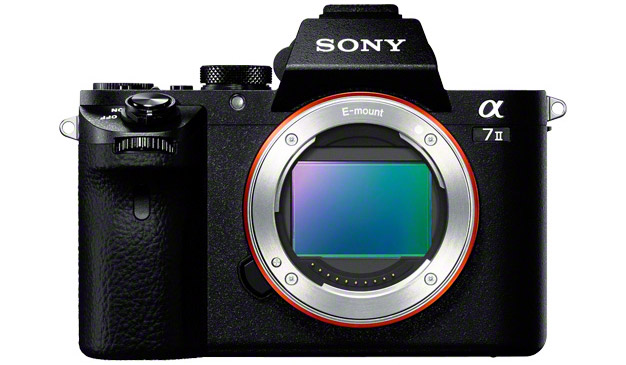Sony A7 II surprises, with world’s first 5-axis image stabilization in a full-frame ILC
posted Thursday, November 20, 2014 at 8:39 AM EST

Sony Japan has unveiled the latest addition to the A7-series of full-frame mirrorless cameras, the new Sony A7 II. The "Mark II" model features not only the world's first 5-axis sensor-shift image stabilization system for a full-frame ILC, but also a number of design tweaks and build quality improvements.

Originally seen on the Olympus E-M5, a 5-axis sensor-shift image stabilization system compensates for yaw, pitch, and roll, as well as vertical and horizontal motion, and provides stabilization for both still image and video recording. The Sony Japan website indicates that the new 5-axis system on the Sony A7 II should provide up to 4.5 stops of stabilization correction.
If you recall, Sony made a big investment into Olympus back in 2012, and using their partnership, it could be that Olympus' technology for body-based IS is making its way into Sony Alpha cameras. (Sony of course has also had body-based IS technology in some of their cameras for years, but the 5-axis aspect of this system is an advancement into an area where Olympus already had expertise.)

Other changes include an updated grip design, including moving the front sub-control dial into a more natural and convenient front-facing location as well as moving the shutter release button out on top of the grip area. This move has given Sony the space to add an additional "C2" custom function button up to the top deck. The custom function buttons are said to support 56 different function assignments for tremendous customizability. In fact, the functionality of the A7 II can be tweaked quite a bit to suit your shooting style, with the C1-3 custom function buttons, as well as the AEL, ISO, AF/MF, and control dial buttons all being programmable with up to 56 different function assignments.

The body design itself has also received a refresh, with what looks like a matte black speckled finish, a change from the clean, smooth semi-gloss black of the predecessor (and other A7-series models). The body construction is a full two-part magnesium alloy shell that's dust- and moisture-resistant, including weather seals on buttons and dials. It's not clear from the translation of the Sony Japan website whether or not the weather-sealing on the A7 II is more robust than the previous models. The Sony A7 II's lens mount has also been improved by using magnesium allow to increase strength and rigidity, which can be especially helpful when using larger, longer, and heavier lenses.

First seen on the Sony A7S, the new A7 II also features improved video recording capabilities including XAVC S format as well as an optional S-Log2 gamma profile for enhanced dynamic range. There is also time code support, clean HDMI output (up to 1080/60p output) with simultaneous internal recording, as well as uncompressed 4:2:2 8-bit output via HDMI into an external recorder. Video recording resolutions tops out at 1080/60p, with 720/120p, 1440 x 1080 and VGA also supported.
The Sony A7 II maintains the same 24.3-megapixel full-frame sensor as its predecessor, along with the Fast Hybrid AF system with the combination of on-sensor phase detect pixels and contrast detect AF. This allows for up to 5fps burst shooting with continuous autofocus, like the A7 before it.
US pricing and availability has not yet been announced, though according to the Sony Japan online store, the Sony A7 II body-only is priced at 189,880 yen or a little over $1,600 USD at the current exchange rate. Note that US pricing may be different when the camera starts shipping here. No date has yet been given for when that might be.
We'll post our detailed impressions as soon as we've had hands-on time, but in the meantime, head over to our camera comprison feature to see how the A7 II stacks up against the competition:
Sony A7 II vs Fuji X-T1
Sony A7 II vs Sony A6000
Sony A7 II vs Olympus E-M1